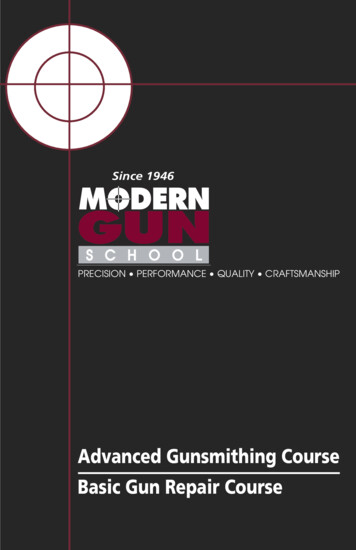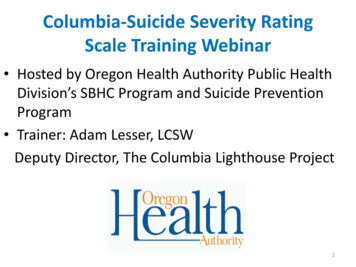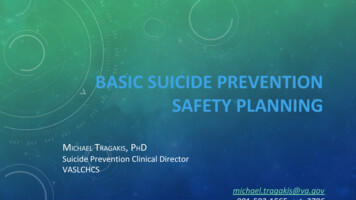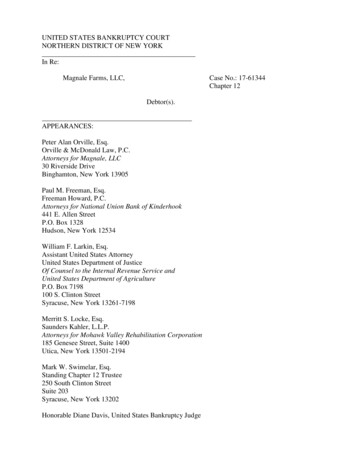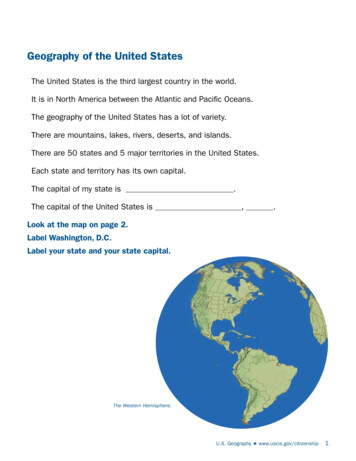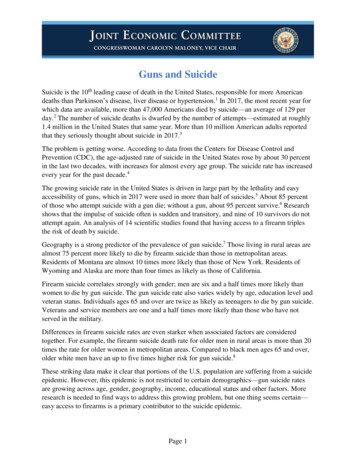
Transcription
Guns and SuicideSuicide is the 10th leading cause of death in the United States, responsible for more Americandeaths than Parkinson’s disease, liver disease or hypertension.1 In 2017, the most recent year forwhich data are available, more than 47,000 Americans died by suicide—an average of 129 perday.2 The number of suicide deaths is dwarfed by the number of attempts—estimated at roughly1.4 million in the United States that same year. More than 10 million American adults reportedthat they seriously thought about suicide in 2017.3The problem is getting worse. According to data from the Centers for Disease Control andPrevention (CDC), the age-adjusted rate of suicide in the United States rose by about 30 percentin the last two decades, with increases for almost every age group. The suicide rate has increasedevery year for the past decade.4The growing suicide rate in the United States is driven in large part by the lethality and easyaccessibility of guns, which in 2017 were used in more than half of suicides.5 About 85 percentof those who attempt suicide with a gun die; without a gun, about 95 percent survive.6 Researchshows that the impulse of suicide often is sudden and transitory, and nine of 10 survivors do notattempt again. An analysis of 14 scientific studies found that having access to a firearm triplesthe risk of death by suicide.Geography is a strong predictor of the prevalence of gun suicide.7 Those living in rural areas arealmost 75 percent more likely to die by firearm suicide than those in metropolitan areas.Residents of Montana are almost 10 times more likely than those of New York. Residents ofWyoming and Alaska are more than four times as likely as those of California.Firearm suicide correlates strongly with gender; men are six and a half times more likely thanwomen to die by gun suicide. The gun suicide rate also varies widely by age, education level andveteran status. Individuals ages 65 and over are twice as likely as teenagers to die by gun suicide.Veterans and service members are one and a half times more likely than those who have notserved in the military.Differences in firearm suicide rates are even starker when associated factors are consideredtogether. For example, the firearm suicide death rate for older men in rural areas is more than 20times the rate for older women in metropolitan areas. Compared to black men ages 65 and over,older white men have an up to five times higher risk for gun suicide.8These striking data make it clear that portions of the U.S. population are suffering from a suicideepidemic. However, this epidemic is not restricted to certain demographics—gun suicide ratesare growing across age, gender, geography, income, educational status and other factors. Moreresearch is needed to find ways to address this growing problem, but one thing seems certain—easy access to firearms is a primary contributor to the suicide epidemic.Page 1
Guns and SuicideKEY FACTS: Suicide is the 10th leading cause of death in the United States. In 2017, more than 47,000 Americans died by suicide. In addition: 1.4 million Americans attempted suicide, and 10.6 million Americans thought seriously about ending their lives. Lifetime medical and work-loss costs due to suicides and suicide attempts are estimated atalmost 70 billion per year. The rate of suicide in the United States rose by about 30 percent in the last two decades. There are 1.5 times more gun suicides each year than gun homicides. Having access to a firearm triples the risk of death by suicide. Firearms were used in more than half of suicides in 2017. For each 10 percentage-point increase in household gun ownership, the youth suicide rateincreases by more than 25 percent. About 85 percent of those who attempt suicide with a gun die compared to only about fivepercent without a gun. The firearm suicide rate is almost 10 times higher in the United States than in other highincome countries. Americans living in rural areas are almost 75 percent more likely to die by gun suicide thanthose in urban areas. Men are 6.5 times more likely to die by gun suicide than women. White men are more than seven times as likely to die by gun suicide as gun homicide. The firearm suicide death rate for older men in rural areas is more than 20 times the rate forolder women in metropolitan areas.Page 2
Guns and SuicideContentsTHE LINK BETWEEN GUNS AND SUICIDE5Suicide is the leading cause of violent death in the United StatesSuicide deaths have increased markedlyMost suicides and violent deaths are gun-relatedEasy access to guns is associated with higher suicide ratesGEOGRAPHY8Firearm suicide is more common in the United States than in other high-income countriesStates with the highest rates of gun ownership have the highest firearm suicide ratesMetro areas have lower firearm suicide rates, but rates vary by regionGENDER, RACE AND AGE9Men are six and a half times more likely to die by gun suicide than womenFirearm suicide is much more prevalent among white menOlder Americans are at a higher riskIncreased suicide rates at midlife leads to a decline in overall U.S. life expectancyGun suicide deaths are increasing among youthFIREARM-RELATED OCCUPATIONS12Veterans have high rates of firearm suicideFirst responders also are at riskCONCLUSION13APPENDIX14Page 3
Guns and SuicidePage 4
Guns and SuicideTHE LINK BETWEEN GUNS AND SUICIDESuicide is the leading cause of violent death in the United StatesSuicide is the leading cause of violent death in the United States. In 2017, there were over 67,000violence-related injury deaths. According to the Centers for Disease Control and Prevention(CDC), the top five causes of violence-related injury deaths that year were firearm suicides (35percent), firearm homicides (22 percent), suicide by suffocation (19 percent), suicide bypoisoning (10 percent) and homicide by cutting/piercing (3 percent).Injury death rates vary widely byage. For this reason,demographers often calculatesuicide and most death rates onan age-specific or age-adjustedbasis. Age-specific rates equal thetotal number of deaths observedamong a specific age group,divided by the population of theage group and multiplied by100,000.9 Age-adjusted ratesweight the observed (“crude”)rate based on a constantunderlying age distribution.Age adjusting ensures thatdifferences over time or bygeographic areas or other factorsare not just a reflection ofdifferent age distributions beingcompared. This report providesstatistics on death rates using datafrom the CDC Web-based InjuryStatistics Query and Reporting System (WISQARS). All death rates are reported as an agespecific rate or an age-adjusted rate based on the 2000 U.S. (standard) population, unlessotherwise noted.The age-adjusted death rate by suicide in the United States in 2017 was 14.0 (per 100,000).10 In2017, the leading cause of violent death when taking into account both the intent and means ofdeath was firearm suicide (23,854), followed by firearm homicide (14,542). The rate of firearmsuicide deaths in the United States in 2017 was 7.3. In comparison, the rate for motor vehicletraffic deaths was 11.9, and for homicide deaths, the rate was 6.1.Page 5
Guns and SuicideMotor Vehicle, Suicide and Firearm Deaths1981 - 201760Number of Fatal Injuries (in 1000s)50All SuicideAll Motor Vehicle40All Firearm30Firearm Suicide2010Firearm Homicide01981 1983 1985 1987 1989 1991 1993 1995 1997 1999 2001 2003 2005 2007 2009 2011 2013 2015 2017Source: CDC WISQARSSuicide deaths have increased markedlySuicide imposes severe costs on American families and society as a whole. According to theCDC, suicide and self-injury cost the economy 70 billion a year, and that is just in lifetimemedical and work-lost costs alone.In the last two decades, the number of suicide deaths in the United States has increasedmarkedly. The suicide rate in the United States rose by about 30 percent, perhaps correlated withincreasing economic distress due to mortgage defaults and rising unemployment before and afterthe recent recession of the early 2000s and the 2007 to 2009 financial crisis.However, a reversal in rates during periods of economic recovery has not been observed. Rather,there has been a secular upward trend in overall suicide rates across the business cycle. Rates foryouth and young adults have increased in more recent years. Data suggest that the increase partlyis fueled by the large and increasing number of firearm suicides since the late-2000s. Among allsuicides (47,173), over half are by firearm (51 percent).Most suicides and violent deaths are gun-relatedIn 2017, there were nearly 40,000 firearm deaths in the United States. Among all firearm deaths,gun suicide is the leading cause of death—making up more than 60 percent of all firearm deaths.Since the CDC began publishing data in 1981, gun suicides have outnumbered gun homicidesevery year. Since 2009, the number of gun suicides has been one and a half times higher than thenumber of gun homicides each year.Page 6
Guns and SuicideShare of Suicide and Homicide Firearm Deaths1981 - 201770%Percent of All Firearm Deaths65%60%55%Firearm Suicide50%45%Firearm Homicide40%35%30%1981 1983 1985 1987 1989 1991 1993 1995 1997 1999 2001 2003 2005 2007 2009 2011 2013 2015 2017Source: CDC WISQARSNote: Other types of firearm deaths include unintentional, intent undetermined and legal intervention.Easy access to guns is associated with higher suicide ratesA 2014 review of 14 different scientific studies concluded that having access to a firearm triplesthe risk of death by suicide.11 Other research has found a correlation between guns and suiciderates, even when controlling for race and gender as well as other factors associated with suicidelike age, education, poverty, unemployment, serious mental illness and substance abuse.12 Thereis a positive association between levels of household gun ownership and overall suicide rates forthe entire population, in every age group and for both men and women at both regional and statelevels.13 One study found that for each 10 percent decline in household firearm ownership therewas an associated decline in the firearm suicide rate of 4 percent.14Having access to a firearm during a moment of increased suicide risk, such as a job loss,increases the risk of completing suicide.15 Research shows that the impulse of suicide istransitory and that access to guns is a risk factor for whether a suicide attempt is fatal. Theinterval between the decision to act and an attempt can be as short as 10 minutes or less, andresearch shows a substitute to a different method is unlikely when a highly lethal method isunavailable. Among adults who have recently purchased a gun, there is a higher firearm suiciderate, especially within the first year of a gun purchase.16The high correlation between access to guns and suicide rates is closely tied to the lethality offirearms—suicide attempts involving a firearm are far more likely to result in death than anPage 7
Guns and Suicideattempt by any other means.17 About 85 percent of those who attempt suicide with a gun diecompared to only about five percent without a gun.18GEOGRAPHYFirearm suicide is more common in the United States than in other high-income countriesFirearm suicide is much more prevalent in the United States than in similar high-incomecountries. According to a recent study (based on 2015 data), the firearm suicide rate was about10 times higher in the United States than in similar industrial countries.19 In other high-incomecountries, the 2019 study found that only five percent of overall suicides are firearm suicides,compared to over half in the United States. The firearm suicide rate in high-gun states (10.3) inthe United States is nearly 15 times higher compared to other high-income counties (0.7).Firearm Suicide Rate, 2015U.S. States vs. High Income CountriesPer 100,000U.S. Low Gun States2.1U.S. Medium Gun States7.1U.S. High Gun States10.3Other High Income Countries0.7051015Source: Grinshteyn and Hemenway, 2019States with the highest rates of gun ownership have the highest firearm suicide ratesMultiple studies have found that high rates of gun ownership are associated with higher rates offirearm suicide across different U.S. states. Overall, the states that rank highest in terms of gunownership also rank among the highest in suicide and firearm suicide rates, while the states thatrank lowest for gun ownership rank among the lowest for overall suicide and firearm suicide.20High suicide gun death rates are concentrated in the Rocky Mountain region and the South.21Montana has the highest suicide firearm death rate in the country (19.4), followed by Wyoming(16.5) and Alaska (16.2). A survey found that these states also have some of the highest gunownership rates in the country.22The percentage of total suicides by firearms is also revealing. In Alabama and Montana, guns areused in nearly 69 percent of all suicides. In Mississippi and West Virginia, the figure is morePage 8
Guns and Suicidethan 65 percent. It is approximately 63 percent in South Carolina, Wyoming and Georgia.Alabama, Alaska, Georgia, Mississippi, Montana, South Carolina, West Virginia and Wyomingall have limited gun safety legislation.23Many states with higher firearm suicide rates lack basic gun safety laws, such as extreme riskprotection order laws.24 Residents of Montana are almost 10 times more likely to die by suicidewith a firearm than those of New York. Residents of Wyoming and Alaska are more than fourtimes as likely to die by firearm suicide as those of California.The situation in some states with tighter gun laws is very different.25 In Massachusetts, only 22percent of suicides involve guns; in New York, only 26 percent; and, in California, about 37percent.Although states with higher rates of gun ownership have higher rates of firearm suicide andoverall suicide, these states have comparable non-firearm suicide rates. This suggests that thestate differences in suicide death rates are tied to having access to firearms.26Metro areas have lower firearm suicide rates, but rates vary by regionThe firearm suicide rate in metro areas is 6.3, whereas the rate in rural (non-metro) areas is muchhigher at 11.0. However, the rates in metro areas vary substantially by region. There are higherrates of firearm suicide in metro areas of rural states in the Rocky Mountain region and theSouth. For example, Oklahoma City, Oklahoma; Salt Lake City, Utah; and Birmingham-Hoover,Alabama have rates more than double the metro average and higher than the national average(13.5, 12.4 and 11.9, respectively).27 From 2012-2013 to 2015-2016, the CDC reports firearmsuicide rates increased faster than the national average in these states.Rounding out the metropolitan statistical areas (MSAs) with the 10 highest firearm suicide ratesare Jacksonville, Florida; Louisville/Jefferson County, Kentucky-Indiana; Phoenix-MesaScottsdale, Arizona; Kansas City, Missouri-Kansas; Las Vegas-Henderson-Paradise, Nevada;Nashville/Davidson-Murfreesboro-Franklin, Tennessee; and Denver-Aurora-Lakewood,Colorado, with rates ranging from 9.6 to 11.The three MSAs with the lowest rates were all in the Northeast: New York-Newark-Jersey City,New York-New Jersey-Pennsylvania; Boston-Cambridge-Newton, Massachusetts-NewHampshire; and Hartford, Connecticut, with rates ranging from 1.5 to 2.5.GENDER, RACE AND AGEMen are six and a half times more likely to die by gun suicide than womenMen are about four times more likely than women to die by suicide. However, the disparity ismuch wider for gun suicides—men are about six and a half times more likely than women to dieby firearm suicide.In 2000, the firearm suicide rate for men was 11.0, while it was 1.5 for women. By 2017, the ratefor men had increased 13 percent to 12.4; while for women, it had increased 28 percent, but onlyto 1.9.Page 9
Guns and SuicideFirearm suicide is much moreprevalent among white menWhite men comprise most of firearmsuicides (79 percent) in the UnitedStates, followed by white women (12percent). Just over half of violentdeaths among white men are by gunsuicide (52 percent). White men aremore than seven times as likely to dieby gun suicide as gun homicide.Among white women, firearmsuicide is tied as the leading cause ofviolent death in the United States,along with death by suicidepoisoning (27 percent, each). Whitewomen are more than twice as likelyto die by gun suicide as gunhomicide.Firearm suicides account for a smaller share of violent deaths among non-whites: 30 percentamong American Indian men, 15 percent among American Indian women, 25 percent amongAsian men, 10 percent among Asian women, 21 percent among Hispanic men, 13 percent amongHispanic women, 12 percent among black men and 9 percent among black women.Gun ownership, which is associated with rates of firearm suicide, also differs greatly acrossracial and ethnic lines. Whites are far more likely than either black people or Hispanics to own agun or to live with someone who owns a gun. Whites are one and a half times more likely thanblack Americans and nearly two and a half times more likely than Hispanics to own a gun.According to the Pew Research Center, 36 percent of whites, 24 percent of black people and 15percent of Hispanics own a gun.28Older Americans are at a higher riskOlder Americans are more likely to die by firearm suicide than younger individuals. Those whoare 65 and older accounted for more than 8,600 of the more than 47,000 suicides in 2017. Thosein the oldest age group—adults ages 85 and older—have one of the highest rates of suicide.29The firearm suicide rate for those ages 85 and over (15.0) is almost three times higher than therate for teens ages 15 to 19 (5.3). Nine in 10 of all firearm deaths in older adults are suicides.Page 10
Guns and SuicideFirearm Suicide RatesMales by Select Age Groups, 2000-2017Deaths/100,000 142016YearSuicide, Males 15 to 19Suicide, Males 20 to 24Suicide, Males 65 and OverSuicide, Males 25 to 64Source: CDC WISQARSIn 2017, the firearm suicide rate for men 65 years old and over (24.3) was nearly double the ratefor all men (12.9). Men ages 65 and older also have a higher firearm suicide rate than men ages25 to 64 (14.6). Compared to black men ages 65 and over, older white men are nearly five timesmore likely to die by firearm-related suicide.Illnesses that are common in older persons, such as dementia, may be risk factors for suicide.30Despite these risk factors, there is less research on reducing the heightened risk of gun suicideamong older Americans. About one in three seniors (ages 65 years or older) owns a gun. Another12 percent live in a household with someone who owns a gun.31Increased suicide rates at midlife leads to a decline in overall U.S. life expectancyResearchers have found a decrease in life expectancy due partly to an increase in suicide amongmiddle-aged white men and women (ages 45 to 54).32 According to professors Anne Case andAngus Deaton, winner of the Nobel Prize in economics, the change from a downward to anupward trend in midlife mortality among whites in the 21st century ended decades of progress inmortality rates. The reversal was observed only in the United States, and in no other high-incomecounty.33 If the earlier progress had continued, the researchers claim that half a million deathswould have been avoided over the fifteen-year period they studied from 1999 to 2013. Deatonand Case coined the term “deaths of despair” to describe deaths from drugs, alcohol and suicideamong less educated and middle-aged whites.Page 11
Guns and SuicideA report by the National Center for Health Statistics found that life expectancy at birth started todecline in 2015 and that progress against many of the leading causes of death has stalled orreversed. The increase in mortality—attributed by many to increasing suicide and firearm-relateddeaths and also to the rapid increase in opioid-related deaths—is found to be concentrated amongless educated and middle-aged whites. These groups have experienced rising mortality since thelate 1990s.34Gun suicide deaths are increasing among youthThe firearm suicide rate for young people is lower than for older adults. According to 2017 CDCdata, the rate for all teens (5.3) is less than half the rate for Americans ages 65 and over (11.8).While suicide is the 10th leading cause of death among Americans, it became the second leadingcause of death for those ages 10 to 34 in 2016.35 Each year, there are over 1,000 children andteen suicide deaths by gun.36The firearm suicide rate among teens (ages 15 to 19) and adults in their early twenties (ages 20 to24) has increased in recent years for both males and females.37 However, the gender disparity infirearm suicides among youth persists. While the firearm suicide rate for males of all ages is sixand a half times higher than for females, the rates among teens and younger adults are nearlyeight times higher for males than for females. From 2013 to 2017, the firearm suicide rateincreased by 10 percent among all men. During this period, it increased by over 50 percent formale teens and by one-third (32 percent) for men in their early twenties.As is true among older Americans, access to firearms has a large effect on the rate of firearmsuicide deaths among young people. For each 10 percentage-point increase in household gunownership, the youth suicide rate increases by more than 25 percent.38 Seventy-five percent ofguns used in adolescent gun suicides come from a parent or other family members.39FIREARM-RELATED OCCUPATIONSVeterans have high rates of firearm suicideAccording to the 2019 National Veteran Suicide Prevention Annual Report, an average of 17veterans died by suicide each day—6,139 veterans in 2017 alone. Suicides among veterans areincreasing. The age- and sex-adjusted suicide rate for the veteran population increased 50 percentbetween 2005 and 2017, from 18.5 to 27.7.Overall suicide patterns differ starkly by the combined effects of veteran status and gender. The2017 rate of suicide among women veterans was more than twice the rate of non-veteran women,while the rate of suicide among male veterans was 130 percent higher than the rate among nonveteran males. The 2017 rate of suicide among male veterans was more than double the rate offemale veterans, 39.1 and 16.8, respectively.40Among veterans, younger adults (ages 18 to 34) had the highest suicide rate (44.5). From 2005 to2017, the suicide rate for younger adults increased by 76 percent. The number of suicides washighest among older veterans (ages 55 to 74 years). Suicide among older adults accounted for 38percent of all suicides among veterans.41Page 12
Guns and SuicideWhile active-duty soldiers may be typically healthier than the general population, theaccessibility of firearms among veterans may increase the risk of firearm suicide. The firearmsuicide rate for veterans is one and a half times higher than for non-veterans.42 Firearms were themethod of suicide in 71 percent of male veteran suicide deaths and 43 percent of female veteransuicide deaths. Among non-veterans, firearm is the method for 54 percent of suicides among menand 31 percent of suicides among women.43First responders also are at riskFirst responders also face suicide rates that exceed those of the overall population. In fact, arecent study found that firefighters and police officers are more likely to die by suicide than inthe line of duty.44 In 2017, at least 103 firefighters died by suicide, compared to 93 firefighterswho died in the line of duty. That same year, there were 140 police officer suicides, compared to129 line of duty deaths, according to the study. Other organizations, such as Blue H.E.L.P.,report the trend continued in 2018, though estimates of the number of suicides differ.45 As ofAugust 1, 2019, Blue H.E.L.P. tracked an increase of 24 percent in police officer suicides sincethe prior year.46CONCLUSIONThe United States is experiencing a suicide epidemic, with more than 47,000 suicide deaths in2017 alone. Guns were used in more than half of all suicide deaths. Access to a gun triples therisk of death by suicide.Firearm suicide rates vary widely by geography. Americans are 10 times more likely to die bygun suicide than residents of other high-income countries. Within the United States, those livingin rural areas are 75 percent more likely to die by firearm suicide than those in large metropolitanareas. Variation among states with different gun laws and rates of gun ownership are striking.For example, residents of Montana are almost 10 times more likely than those of New York.Firearm suicide also is closely associated with gender, race and age—with death rates for mensix and a half times higher than for women, twice as high for white people as for black people,and nearly three times higher for those over age 85 than for teens. Members of the military andfirst responders also are at high risk.Individuals with more than one high risk factor are many times more vulnerable than individualswith low risk factors. For example, the firearm suicide rate for older men in rural areas is morethan 20 times the rate for older women in metropolitan areas. For Americans in thesedemographics, gun suicide is a crisis.Page 13
Guns and SuicideAPPENDIXFirearm Suicide Rates by Year and Gender, All 102011201220132014201520162017All AgesBoth rce: CDC WISQARS. Age-adjusted rates (base year is 2000).Crisis Resources For any life-threatening emergency, call 911 immediately.If you are experiencing suicidal thoughts, call the National Suicide Prevention Lifeline at1-800-273-TALK (8255).Crisis Text Line: You can text NAMI to 741-741 to be connected to a free, trained crisiscounselor.Page 14
Guns and SuicideFirearm Suicide Rates by Year, Among Men for Select Age GroupsMales by Age dultsWorkingAgeRetirementAge(0 to 14)(15 to 19)(20 to 24)(25 to 64)(65 and 2811.1611.4111.0211.4212.0913.3614.54Source: CDC WISQARS. Age-specific rates.Page 3223.8324.223.9223.9824.33
Guns and SuicideFirearm Suicide Rates by State, Among Men for Select Age Groups rniaColoradoConnecticutDelawareDistrict of kaNevadaNew HampshireNew JerseyNew MexicoNew YorkNorth CarolinaNorth DakotaOhioOklahomaOregonPennsylvaniaRhode IslandSouth CarolinaSouth est VirginiaWisconsinWyomingAll Ages(20 to 119.792015.5314.617.0915.3331.05(25 to 0.7814.6524.0320.4915.1114.3226.1516.2529.12(65 and Source: CDC WISQARS. Some data for Rhode Island and Washington, D.C. not shown due to small sample size.Age-adjusted rates for all ages (base year is 2000); otherwise age-specific rates shown.Page 16
Guns and SuicideGun Ownership, 2017By Geography, Gender and RacePersonally Owns a lWomen441031Suburban421236WestTotal (%)2710MidwestUrbanLives with a Gun Owner493221Source: Pew Research Center. Self-reported responses collected by survey.Note: Percents shown may not add to subtotals due to rounding.Page 17
Guns and SuicideKochanek, David D. et al. 2019. “Deaths: Final Data for 2017.” National Vital Statistics Reports (NVSR) 68/nvsr68 09-508.pdf.2American Foundation for Suicide Prevention (AFSP). n.d. “Suicide Statistics.” AFSP. Retrieved September 24, 2019. https://afsp.org/aboutsuicide/suicide-statistics/; Heron, Melonie. 2019. “Deaths: Leading Causes for 2017. Centers for Disease Control and Prevention, National Centerfor Health Statistics, National Statistics Reports 68(6):1-76. https://www.cdc.gov/nchs/data/nvsr/nvsr68/nvsr68 06-508.pdf.3Centers for Disease Control and Prevention (CDC). n.d. “Preventing Suicide.” Accessed September 27, e/fastfact.html.4Hedegaard, Holly, Sally C. Curtin and Margaret Warner. 2018. “Suicide Rates in the United States Continue to Increase.” NCHS Data Brief(309):1–8. https://www.ncbi.nlm.nih.gov/pubmed/30312151; Hedeg
Page 1 Guns and Suicide Suicide is the 10th leading cause of death in the United States, responsible for more American deaths than Parkinson’s disease, liver disease or hypertension.1 In 2017, the most recent year for which data are available, more th


